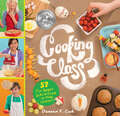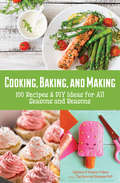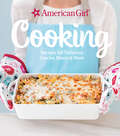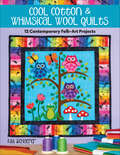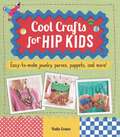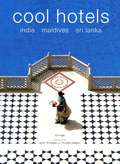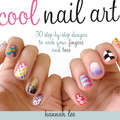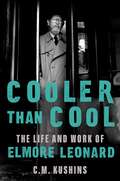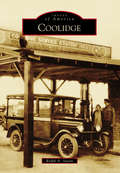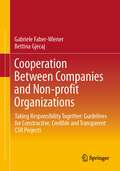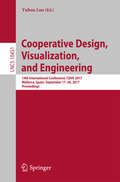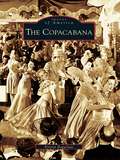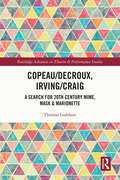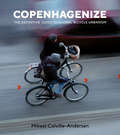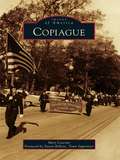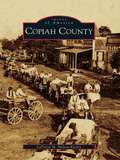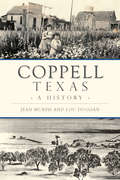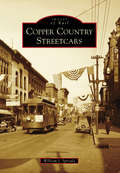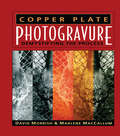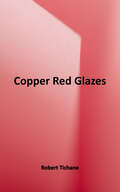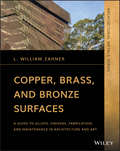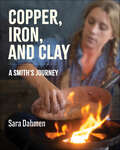- Table View
- List View
Cooking Class: 57 Fun Recipes Kids Will Love to Make (and Eat!) (Cooking Class Ser.)
by Deanna F. CookThe kids are taking over the kitchen! Deanna F. Cook presents more than 50 recipes designed for the cooking abilities and tastes of children ages 6 to 12. Basic cooking techniques are explained in kid-friendly language, and recipes include favorites like applesauce, French toast, popcorn chicken, pizza, and more. Full of fresh, healthy ingredients and featuring imaginative presentations like egg mice, fruit flowers, and mashed potato clouds, Cooking Class brings inspiration and confidence to the chefs of the future.
Cooking, Baking, and Making: 100 Recipes & DIY Ideas for All Seasons and Reasons
by Cynthia O'Connor O'HaraA beautifully illustrated book of &“fantastic [and] delightfully doable&” recipes and DIY crafts from the creator of the Harried Housewife blog (Stylish Southern Mama). In Cooking, Baking, and Making, noted home cook and &“Harried Housewife&” Cynthia O&’Connor O&’Hara proves that living the handmade life doesn&’t require a life of leisure. This all-inclusive guide is bursting with DIY recipes and ideas for the entire year—holidays included! Beautifully photographed and presented, Cynthia&’s user-friendly projects and dishes make replicating her flavors and designs as natural as the changing of the seasons. Inside, you will find sixty recipes with bonus designs and forty ideas that tie your home together all year round. For example: Spring: Serve Herbed Cucumber Tea Sandwiches and a make a Spring CenterpieceSummer: Delight your guests with Fresh Berries with Cannoli Cream and make your own decorative coastersAutumn: Bake Dilled Beer and Cheddar Bread and make Autumn Harvest PotpourriWinter: Enjoy Creamy Eggnog Cupcakes and make Festive Votives &“A quick and easy cheat sheet for becoming the hostess with the mostess year round!&” —Molly Sharry
Cooking: Recipes for Delicious Snacks, Meals & More (American Girl)
by American GirlLearn how to whip up tasty treats for movie nights, picnics, fiestas, family dinners, and more with this Parents’ Choice Award® winner.Cook up some fun with American Girl Cooking—the perfect cookbook for the emerging chef (and American Girl fan) in your family. Packed with great, easy-to-follow recipes fit for any occasion, this new title will inspire young cooks to get in the kitchen and create delicious, wholesome dishes and give a great sense of accomplishment.Being able to cook good food is a skill you’ll enjoy and benefit from your entire life. With this book as your very own cooking coach, learn how to make tasty and nutritious snacks, soups, salads, main dishes, and more to share with your friends and family.Snacks:From caprese kebabs to lemony hummus to hot cheese dip, these recipes are perfect for sharing and satisfying between-meal cravings.Soups & Salads: Featuring comforting favorites like chicken noodle soup and creamy tomato soup with cheese toasts and lighter fare like taco and BLT salads, there’s something here for everyone.Main Dishes: A wide range of impressive-yet-easy dinners, such as rosemary roast chicken, spaghetti and meatballs, and fish tacos with slaw, are both nourishing and delectable.Side Dishes: Buttery peas with mint, creamiest mashed potatoes, roasted carrots, cheesy garlic bread, and more round out any meal.American Girl Cooking goes with the exclusive line of cookware products from Williams-Sonoma and American Girl, but these delicious recipes can also be made with the utensils you already have in your home. This companion title to American Girl Baking will be a staple in the kitchen for your little chef.
Cool Beer Labels: The Best Art & Design from Breweries Around the World
by Daniel BellonCheers to beer design!The days of boring, mass-produced yellow fizz-water are all but over. These days, independent beer makers are creating a wide variety of interesting beers that exhibit a vast range of depth and flavor. Beer is more than a beverage--it's an artisan craft championed by talented people devoted to quality and good taste. And as craft beer and home brewing continue to grow by leaps and bounds, the culture of beer has made the shift from big business to an industry filled with people who truly care about what they make. And that attention to detail goes for the art and packaging as well as the brews themselves.Cool Beer Labels explores the art and design of beer culture from labels to cans to growlers and more. Inside you'll find:More than 400 full color examples of beer labels from craft and small breweries around the worldCase studies from working designersInterviews with brewery owners and master brewersAn exploration of breweries by regionAnd more Whether you are a visual creative looking for packaging design inspiration or simply part of the growing community of people who enjoy home brewing, craft beers and beer culture, you're sure to enjoy cracking open a cold one and settling back to enjoy this art-filled celebration of beer.
Cool Cat (Twin Texts)
by Judy CooperTwin Texts pair fiction and nonfiction texts in a way that engages emergent readers. High-interest topics and strong visuals make these books exciting to read. The program supports the following curriculum strands: Life Science, Earth Science, Physical Science, Citizenship, America, People and Places, Math, Self-Awareness. Children will enjoy these interesting, fact-based books and wonderful stories as they sort the world of reality from the world of make-believe.
Cool Cotton & Whimsical Wool Quilts: 12 Contemporary Folk-Art Projects
by Kim SchaeferSew funky folk-art fun! Combine bursts of cotton color with wool wildlife, flowers, and more! Best-selling author Kim Schaefer introduces 12 new quilt projects in her beloved whimsical, modern, folk-art style. The quilts are perfect for beginners to explore easy fusible appliqué projects, as well as experienced stitchers, who can enjoy these brand new designs. Just layer your felted wool pieces, from flamingos, owls, bees, potted flowers, and much more, and add to your cotton fabric background. 12 contemporary quilt projects in Kim’s classic whimsical style Create a colorful world using cotton fabrics and felted wool appliqué Beginners welcome! Every stitcher from novice to experienced can enjoy these projects
Cool Crafts for Hip Kids
by Katie EvansGet ready to create! This beautifully photographed crafts book contains 16 simple projects that can be completed without a sewing machine--perfect for young readers new to crafts! These crafts are all done by hand and are designed to help readers guide themselves through the process with little assistance. Using easy instructions, friendly diagrams, clear and cute photographs, and imaginative vintage designs, this is a must-have for kids passionate about creating.
Cool Hotels
by Jacob Termansen Kim Inglis Pia Marie MolbechCool Hotels showcases the best hotels in India, the Maldives and Sri Lanka. Be it a rustic retreat or a five-star, super-deluxe resort that can hold its own globally, all are at the cutting-edge of the new wave of hotel design and management. Each property has been hand-picked according to a set of criteria that includes a strong design aesthetic, architectural integrity, a commitment to service and a sense of individuality. A million miles away from cookie-cutter approach of chain hotels. Many of the properties have never been featured in guides before and many are just recently opened. With over 500 ravishingly beautiful full color photographs, Cool Hotels is the first in a series of hotel guides focusing on Asia. Ultimately these will be the definitive guides exclusively showcasing the best of Asia's unique places to stay.
Cool Hotels
by Jacob Termansen Kim Inglis Pia Marie MolbechCool Hotels showcases the best hotels in India, the Maldives and Sri Lanka. Be it a rustic retreat or a five-star, super-deluxe resort that can hold its own globally, all are at the cutting-edge of the new wave of hotel design and management. Each property has been hand-picked according to a set of criteria that includes a strong design aesthetic, architectural integrity, a commitment to service and a sense of individuality. A million miles away from cookie-cutter approach of chain hotels. Many of the properties have never been featured in guides before and many are just recently opened. With over 500 ravishingly beautiful full color photographs, Cool Hotels is the first in a series of hotel guides focusing on Asia. Ultimately these will be the definitive guides exclusively showcasing the best of Asia's unique places to stay.
Cool Nail Art: 30 Step-by-Step Designs to Rock Your Fingers and Toes
by Hannah LeeCreative nails are the best accessory! Hannah Lee, creator of the popular YouTube Channel Hannah Rox Nails, shares more than thirty new nail designs in Cool Nail Art. With tips on how to prep your manicure, clear step-by-step instructions and easy-to-use tools, you can create fabulous nail art designs in your own home. Learn easy techniques, including dotting, decals, taping, striping and gradients. Choose from thirty-five great designs or try one of the many variations. Learn how to adapt designs for your toes for a complete look. Create designs using at-home items like toothpicks and painter's tape.
Cooler Than Cool: The Life and Work of Elmore Leonard
by C. M. KushinsDrawing on unprecedented archival and family access, Cooler Than Cool: The Life of Elmore Leonard, is the first comprehensive biography of the master American crime writer, author of witty, gritty bestsellers like Get Shorty and Raylan.Over the course of his sixty-year career, Elmore Leonard, “the Dickens of Detroit,” published forty-five novels that have had enduring appeal to readers around the world. Revered by Martin Amis, Margaret Atwood, Raymond Carver, and Stephen King, his books were innovative in their blending of a Hemingway-inspired noirish minimalism and a masterful use of realistic dialogue over exposition—a direct evolution spurred by his years as a screenwriter.Leonard’s fiction contained many layers, and at the heart of his work were progressive themes, stemming from his years as a student of the Jesuit religious order, his personal beliefs in social justice, and his successful battle over alcoholism. He drew inspiration from greats like Raymond Chandler and Dashiell Hammett, but the true motivation and brilliance behind his crime writing was the ongoing class struggle to achieve the American Dream—often seen through the eyes of law enforcement officers and the criminals they vowed to apprehend.C. M. Kushins tells Leonard’s full life story against recurring themes and evolving storytelling methods of his work, drawing on interviews with primary sources ranging from Leonard’s family and friends to those who acted in, produced, and directed his work onscreen. He also includes never-before-published excerpts from Leonard’s unfinished final novel and planned memoir. Definitive and revealing, Cooler Than Cool shows Leonard emerging as one of the last writers of the “pulp fiction” era of midcentury America, to ultimately become one of the most successful storytellers of the twentieth century, whose influence continues to have far-reaching effects on both contemporary crime fiction and American filmmaking.
Coolidge
by Ralph A. SwainEven by Arizona standards, Coolidge is a relatively "new" town. Its original site was platted in 1925 with a modest 80 acres purchased by Phoenix businessman Richard J. Jones, and it would be another 20 years before the town was incorporated. Nevertheless, the Coolidge environs possess a rich and colorful history going back several thousand years when the ancestral Sonoran people began building permanent structures and constructing canals to divert Gila River water for their crops. Two hundred years after the ancient civilization abandoned the area, Spanish explorers passed through on their way to California. But it was ultimately the establishment of main line rail service, the construction of a dam, and the building of the only north-south highway between Tucson and Phoenix that led to the formation of this town named after America's 30th president.
Cooperation Between Companies and Non-profit Organizations: Taking Responsibility Together: Guidelines for Constructive, Credible and Transparent CSR Projects
by Gabriele Faber-Wiener Bettina GjecajThis book describes how cooperation between companies and non-profit organizations can be successfully structured. Companies want and need to take on more social responsibility, and joint projects with non-profit organizations are therefore more in demand than ever. This is not about maximizing profits through greenwashing or token commitments, but about serious corporate social responsibility projects and purpose strategies that strengthen the reputation on both sides. This requires a structured, transparent approach from the outset.The authors explain the theoretical basis and provide practical guidance on how the initiation of cooperation projects can lead to a credible and sustainable collaboration with added value for all stakeholders. An elementary part of the book is the "Code for Transparent Cooperation", a proven framework that can be applied directly in practice.A book for CSR, communication, marketing and compliance managers in companiesand non-profit organizations who strive for clear rules and an open dialogue at eye level.Anyone who acts as a credible driver of transformation would do well to operate sustainably themselves. Transparency creates credibility and reliability. The more an organization's goals shape the design of partnerships with companies, the more authentic they can appear to the outside world. This guide provides helpful tips and orientation on how to achieve coherence.Dipl.theol. Yvonne Zwick, Chairwoman of B.A.U.M. e.V. - Network for Sustainable Management, HamburgNon-profit organizations are central pillars of our society. Especially in times of disruption and change, their performance is of increasing importance. The prerequisite for this is independence - also in cooperation with companies. This book helps companies and non-profit organizations to understand their counterparts and establish stable collaborations.Dr. Günther Lutschinger, Managing Director of Fundraising Association Austria, ViennaThe time for lone wolves is over. If we are to achieve the Paris climate targets, companies must offer profitable solutions for people and the planet. It's all about: How do I tackle it? The new book by Gabriele Faber-Wiener and Bettina Gjecaj focuses in particular on partnerships with non-profit organizations and aims to prepare the ground for successful collaboration.Daniela Knieling, Managing Director respACT and Network Representative Global Compact Network Austria, ViennaCredibility, responsibility and transparency are the guarantee and basis for the sustainable development of companies. A thriving, trusting cooperation between companies and non-profit organizations helps to answer political and social questions and is a profound approach to solving complex ecological problems.Ernst Ternon, MBA MSc MSc, Head of Green Marketing, Wieselburg Campus, Wiener Neustadt University of Applied Sciences
Cooperative Design, Visualization, and Engineering: 14th International Conference, CDVE 2017, Mallorca, Spain, September 17-20, 2017, Proceedings (Lecture Notes in Computer Science #10451)
by Yuhua LuoThis book constitutes the refereed proceedings of the 4th International Conference on Cooperative Design, Visualization, and Engineering, CDVE 2007, held in Shanghai, China in September 2007. The papers presented were carefully reviewed from numerous submissions. The papers cover all current issues in cooperative design, visualization, and engineering, ranging from theoretical and methodological topics to various systems and frameworks to applications in a variety of fields.
Copacabana, The
by Kristin BaggelaarIt has been years since New York has seen anything quite like the old Copacabana. The Copa, Manhattan's best-known night club, was also the most popular nightspot in America. From the moment it burst onto the scene in 1940, an aura of glamour and sophistication hovered over the Copa. It was a luminous glow that, over the course of five decades, served this illustrious establishment well, beckoning the people who made it famous-Hollywood stars, sports heroes, foreign dignitaries, and the town's leading families, including the Kennedys, the Roosevelts, and the Du Ponts. The Copa was a showcase for past, present, and future stars, including Joe E. Lewis, Sophie Tucker, Jimmy Durante, Julie Wilson, Tony Orlando, and Wayne Newton. Through vintage photographs and stories from performers, Copa Girls, and other people connected with the Copa's history, The Copacabana chronicles how this landmark institution became an American cultural icon.
Copeau/Decroux, Irving/Craig: A Search for 20th Century Mime, Mask & Marionette (Routledge Advances in Theatre & Performance Studies)
by Thomas G LeabhartIn this series of essays, Thomas Leabhart presents a thorough overview and analysis of Etienne Decroux’s artistic genealogy. After four years’ apprenticeship with Decroux, Thomas Leabhart began to research and discover how forebears and contemporaries might have influenced Decroux’s project. Decades of digging revealed striking correspondences that often led to adjacent fields—art history, philosophy, and anthropology—forays wherein Leabhart’s appreciation of Decroux and his "kinsfolk," who themselves transgressed traditional frontiers, increased. The following essays, composed over a 30-year period, find a common source in a darkened Prague cinema where people gasped at a wooden doll’s sudden reversal of fortune. These essays: investigate the source of that astonishment; continue Leabhart's examination of Decroux’s "family tree"; consider how Copeau's and Decroux's keen observation of animal movement influenced their actor training; record the challenging and paradoxical improvisations chez Decroux; and recall Decroux’s debt to sculpture, poster art, sport and masks. These essays will be of great interest to students, scholars and practitioners in theatre and performance studies.
Copenhagenize: The Definitive Guide to Global Bicycle Urbanism
by Mikael Colville-AndersenThe bicycle enjoyed a starring role in urban history over a century ago, but now it is back, stronger than ever. It is the single most important tool for improving our cities. Designing around it is the most efficient way to make our cities life-sized—to scale cities for humans. It is time to cement the bicycle firmly in the urban narrative in US and global cities.Enter urban designer Mikael Colville-Andersen. He has worked for dozens of global cities on bicycle planning, strategy, infrastructure design, and communication. He is known around the world for his colorful personality and enthusiasm for the role of bike in urban design. In Copenhagenize, he shows cities how to effectively and profitably re-establish the bicycle as a respected, accepted, and feasible form of transportation.Building on his popular blog of the same name, Copenhagenize offers vivid project descriptions, engaging stories, and best practices, alongside beautiful and informative visuals to show how to make the bicycle an easy, preferred part ofeveryday urban life.Copenhagenize will serve as inspiration for everyone working to get the bicycle back into our cities. It will give planners and designers the ammunition to push back against the Automobile Age and convince the skeptics of the value of the life-sized city. This is not a guide on how to become Copenhagen, but how to learn from the successes and failures (yes, failures) of Copenhagen and other cities around the world that are striving to become more livable.We need to act in order to save our cities—and us—from ourselves. Copenhagenize shows the path forward.
Copiague
by Mary Cascone Steven BelloneAlong the shores of Long Island's Great South Bay, the Copiague area was a haven for Native Americans and, later, colonial settlers. Previously known as Huntington South, East Amityville, Great Neck, and Powell's, the hamlet adopted the name Copiague in the 1890s. Pres. George Washington's celebrated 1790 sojourn is one of the high points in Copiague history, as are the visits of famed wireless inventor Guglielmo Marconi in the early 1900s, when he came to review his namesake Marconiville community. In the 1920s, rural Copiague grew to include the beach communities of American Venice, Amity Harbor, and Hawkins Estates and set the stage for the monumental suburban expansion of the 1950s. Beginning in the early 20th century, Copiague also became the adopted home to immigrants from all around the world. Copiague has a rich tradition of community service institutions--its fire department, public schools, veterans' organizations, and churches, including Bethel A.M.E. Church, celebrated as the oldest black church on Long Island.
Copiah County (Images of America)
by LaTricia M. Nelson-EasleyNamed after a Native American word meaning "calling panther," Copiah County was organized after an agreement was reached with the Choctaw Indians in the Treaty of Doak's Stand in 1820. Located 20 miles from the state capital of Jackson, the county was organized in January 1823 and quickly became an agricultural and manufacturing namesake. Once known as the "Tomato Capital of the World," the county was the location of the largest Chautauqua assemblies in the South and the site of the founding of the Mississippi Parent Teacher Association. The extinct town of Brown's Wells once produced spring water that "healed" the rich and famous. Notable citizens from Copiah County include bluesman Robert Johnson; Maj. R. W. Millsaps, for whom Millsaps College was named; Burnita Shelton Matthews, the first female federal district court judge; Pat Harrison, a former representative and senator; Albert Gallatin Brown, a former governor; and Fannye Cook, an author and the first director of the Mississippi Museum of Natural Science.
Coppell, Texas: A History (Brief History)
by Jean Murph Lou DugganCoppell history is rooted in peace and community. In 1843, Sam Houston met with ten native tribes along Grapevine Springs Creek to negotiate an accord to end fighting and allow trade and settlement in the area. When Dallas/Fort Worth International Airport opened in 1974, Coppell transformed from a farming hamlet into a thriving town with expanding economic opportunity. Through firsthand accounts with longtime residents and meticulous research, authors Jean Murph and Lou Duggan unfold the contemplative story of a complex and historic community.
Copper Country Streetcars
by William J. SprouleDuring the early 1900s, copper mining was at its peak in the "Copper Country" of Michigan's Upper Peninsula. Numerous communities sprang up throughout the region, but travel between towns was difficult as the roads were not paved and became impassable during the winter months when over 200 inches of snow would inundate the area. The poor travel conditions and boom period in the Copper Country were instrumental factors that resulted in the construction of a streetcar line to serve the area. Service began in 1900, and the network was extended several times over the next few years. Ridership peaked in 1910, when over six million passengers rode the system; however, it declined in the 1920s as automobiles became more popular, roads were improved, and the copper boom subsided. Service finally ended in 1932. It is a fascinating history that surprises many of today's residents that streetcars operated in the area.
Copper Plate Photogravure: Demystifying the Process (Alternative Process Photography Ser.)
by David Morrish Marlene MacCallumCopper Plate Photogravure describes in comprehensive detail the technique of traditional copper plate photogravure as would be practiced by visual artists using normally available facilities and materials. Attention is paid to step-by-step guidance through the many stages of the process. A detailed manual of technique, Copper Plate Photogravure also offers the history of the medium and reference to past alternative methods of practice.Copper Plate Photogravure: Demystifying the Process is part of the current revitalization of one of the most satisfyingly beautiful image-making processes. The range of ink color and paper quality possibilities is endless. The potential for handwork and alteration of the copper plate provides yet another realm of expressive variation. The subject matter and the treatment are as variable and broad as photography itself. This book's purpose is to demystify and clarify what is a complex but altogether "do-able" photomechanical process using currently available materials. With Copper Plate Photogravure, you will learn how to:· produce a full-scale film positive from a photographic negative· sensitize the gravure tissue to prepare it for exposure to the positive · prepare the plate and develop the gelatin resist prior to etching· prepare the various strengths of etching solutions and etch the plate to achieve a full tonal scale· rework the plate using printmaking tools to correct flaws or to adjust the image for aesthetic reasons· use the appropriate printing inks, ink additives, quality papers, and printshop equipment to produce a high quality printA historical survey and appendices of detailed technical information, charts, and tables are included, as well as a list of suppliers and sources for the materials required, some of which are highly specialized. A comprehensive glossary introduces the non-photographer or non-printmaker to many of the terms particular to those fields and associated with this process.
Copper Red Glazes: A Guide to Producing these Elusive Glazes
by Robert TichaneA reference guide for potters who want success with copper-red glazes without doing extensive and frustrating experimentation. Robert Tichane's approach provides a clear account of the processes involved in the production of copper-red glazes that have relevance for potters beyond copper red.
Copper, Brass, and Bronze Surfaces: A Guide to Alloys, Finishes, Fabrication, and Maintenance in Architecture and Art (Architectural Metals Series)
by L. William ZahnerA FULL-COLOR GUIDE FOR ARCHITECTS AND DESIGN PROFESSIONALS TO THE SELECTION AND APPLICATION OF COPPER, BRASS, AND BRONZE Copper, Brass, and Bronze Surfaces, third in Zahner's Architectural Metals Series, provides a comprehensive and authoritative treatment of copper, brass, and bronze applications in architecture and art. If offers architecture and design professionals the information they need to ensure proper maintenance and fabrication techniques through detailed information and full-color images. It covers everything from the history of the metals and choosing the right alloy, to detailed information on a variety of surface and chemical finishes and corrosion resistance. The book also features case studies that offer strategies for designing and executing successful projects using copper, brass, and bronze. Copper, Brass, and Bronze Surfaces is filled with illustrated case studies that present comprehensive coverage of how each metal is used in creating surfaces for building exteriors, interiors, and art finishes. All the books in Zahner's Architectural Metals Series offer in-depth coverage of today's most commonly used metals in architecture and art. This visual guide: Features full-color images of a variety of copper, brass, and bronze finishes, colors, textures, and forms Includes case studies with performance data that feature strategies on how to design and execute successful projects using copper, brass, and bronze Offers methods to address corrosion, before and after it occurs Explains the significance of the different alloys and the forms available to the designer Discusses what to expect when using copper, brass, and bronze in various exposures Written for architecture professionals, metal fabricators and developers, architecture students, designers, and artists working with metals, Copper, Brass, and Bronze Surfaces offers a logical framework for the selection and application of copper, brass, and bronze in all aspects of architecture.
Copper, Iron, and Clay: A Smith's Journey
by Sara Dahmen“Sara Dahmen's beautifully photographed book is the most useful resource on copper cookware I've come across. An accomplished coppersmith, Sara not only shows us how copper cookware is made, but how to cook with it (along with a myriad of recipes), and care for it, too. The mysteries and mystique of cast-iron and clay cookware are explored in depth as well. Copper, Iron, and Clay is an indispensable cookware reference that every cook should have in their library. I learned so much from it . . . and you will too!” —David Lebovitz, author of My Paris Kitchen and Drinking FrenchA gorgeous, full-color illustrated love letter to our most revered cookware—copper pots, cast-iron skillets, and classic stoneware—and the artistry and workmanship behind them, written by an expert craftsperson, perhaps the only woman coppersmith in America.Today, most people are concerned about eating seasonal, organic, and local food. But we don’t think about how the choices we make about our pots, pans, and bowls can also enhance our meals and our lives. Sara Dahmen believes understanding the origins of the cookware we use to make our food is just as essential. Copper, Iron, and Clay, is a beautiful photographic history of our cooking tools and their fundamental uses in the modern kitchen, accompanied by recipes that showcase the best features of various cooking materials.Interested in history and traditional pioneer kitchens, early cooking methods, and original metals used in pots during the early years of America, Sara became obsessed with the crafts of copper- and tin-smithing for kitchenware—specialty trades that are nearly extinct in the United States today. She embarked on a journey to locate artisans nationwide familiar with the old ways who could teach and inspire her. She began making her own cookware not only to connect with the artisanal traditions of our nation’s past, but to adopt the pioneer kitchen to cook and eat healthier today. Why cook fantastic, healthful food in a cheap pan coated with toxic chemicals and inorganic elements? she asks. If you buy one high-quality item made from natural materials, it can serve your family for generations.Richly illustrated with dozens of stunning color photographs, Copper, Iron, and Clay showcases each material, exploring its fascinating history, fundamental science—including which elements work best for various cooking methods—and its practical uses today. It also features fascinating interviews with industry insiders, including cookware artisans, chefs, entrepreneurs, and manufacturers from around the world. In addition, Sara provides recipes from her own kitchen and some of her famous chef friends, as well as a few historical favorites—all which are optimized for particular kinds of cookware.
